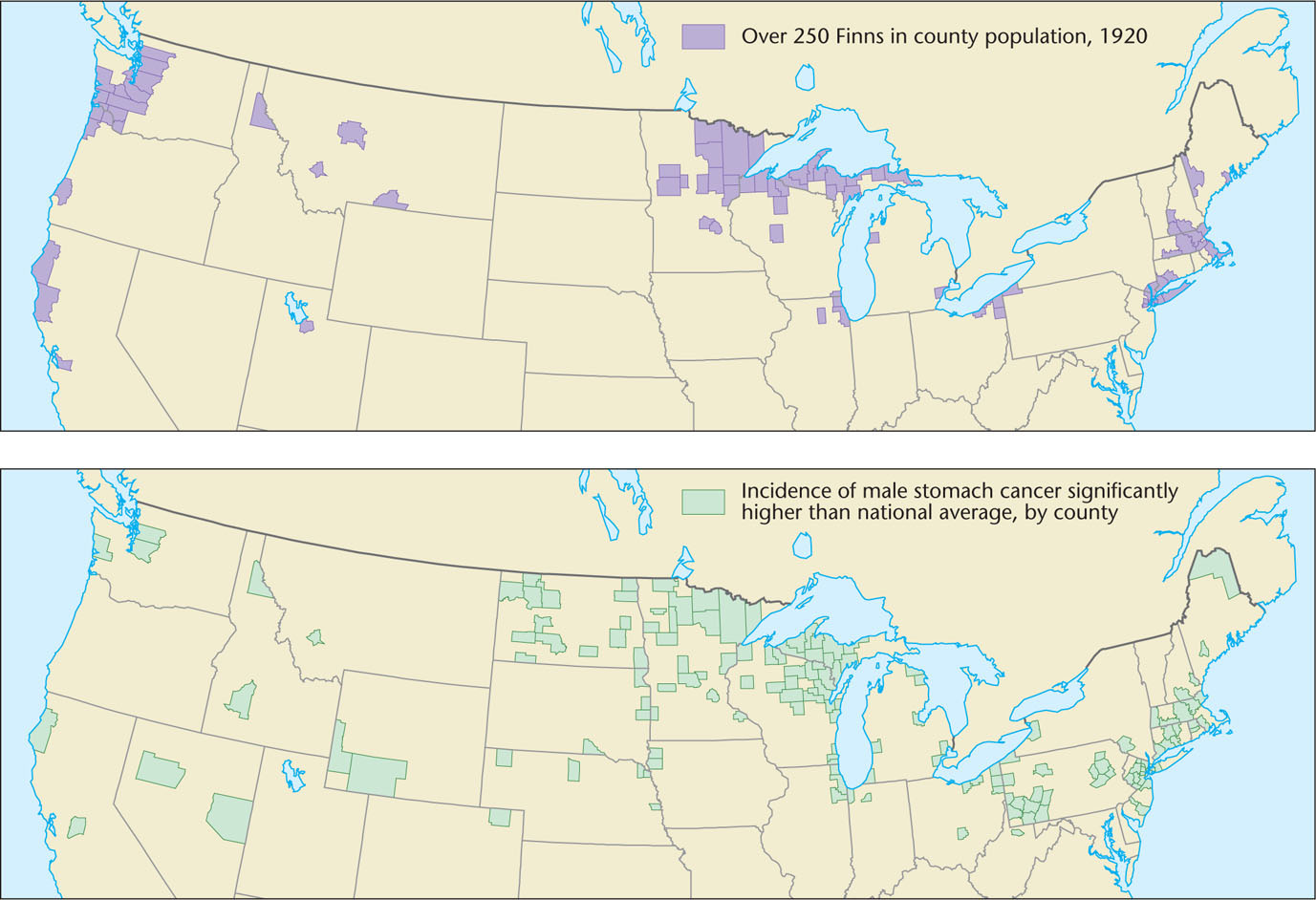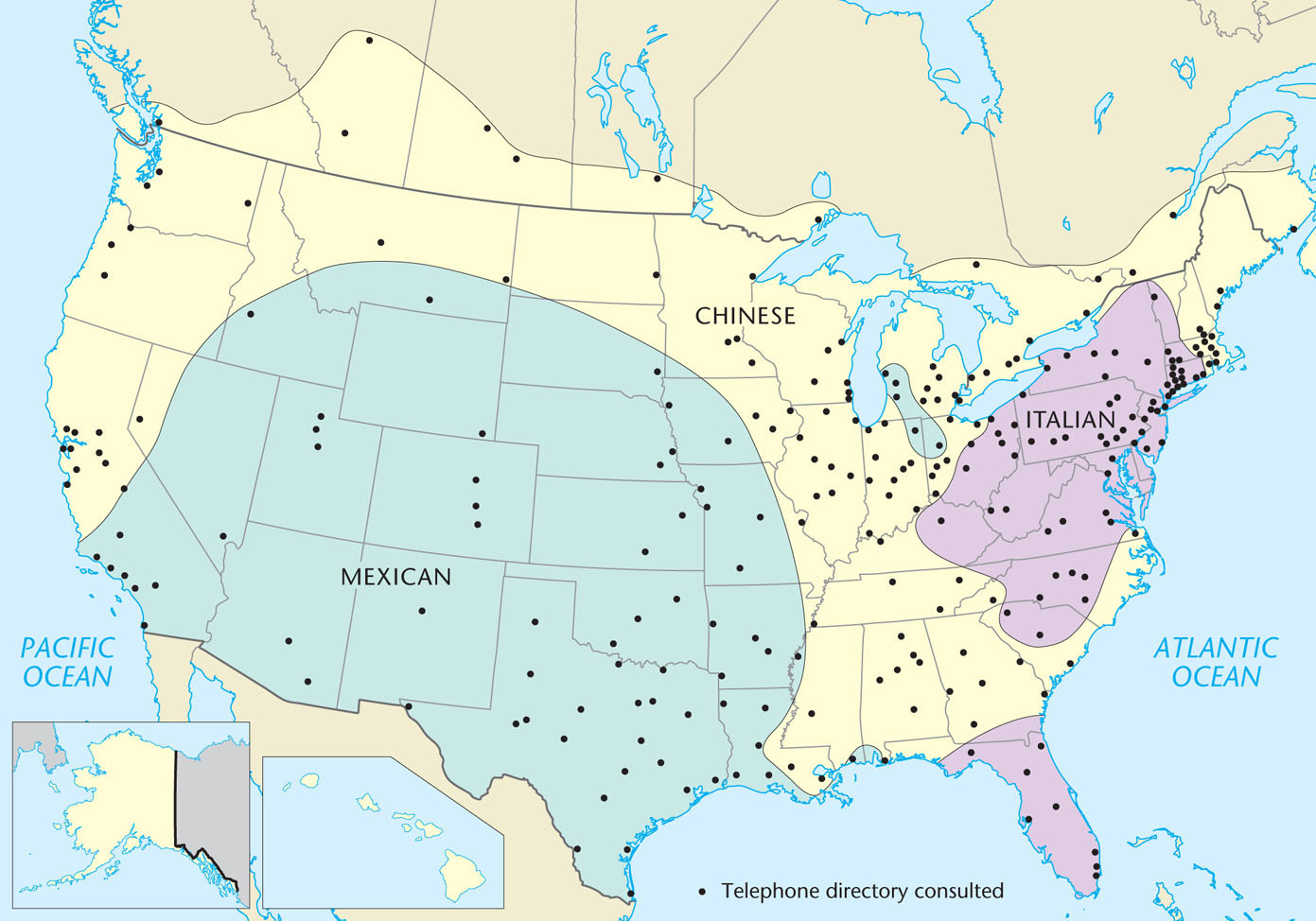Ethnic Cultural Interaction
Ethnic Cultural Interaction

How is ethnic identity linked to other aspects of culture? If ethnicity possesses a vital link to ecology, it is also firmly integrated into the fabric of culture. The very concept of ethnicity can find a basis in the theme of cultural interaction. For example, ethnicity plays a role in what members of an ethnic group eat, what religious faith they practice, how they vote, whom they marry, how they earn a living, and in what ways they spend their leisure time. In the process, an identity emerges. The complicated pattern of ethnic homelands, ghettos, and neighborhoods influences the spatial distribution of diverse cultural phenomena (Figure 5.26).

Thinking Geographically
Question
What ethnic behavior on the part of Finnish-Americans might explain this striking spatial correlation?
140
Ethnicity and Business Activity
Ethnicity and Business Activity
Differential ethnic preferences give rise to distinct patterns of purchasing goods and services. These patterns, in turn, are reflected in the types of businesses and services available in different ethnic neighborhoods in a city. Geographer Keith Harries made a detailed study of businesses in the Los Angeles urban area in the early 1970s, comparing Anglo-American, African-American, and Mexican-American neighborhoods. He found that East Los Angeles Chicano neighborhoods had unusually large numbers of food stores, eating and drinking places, personal services, and repair shops. These Hispanic areas had, in fact, three times as many food stores as Anglo neighborhoods. In large part, this pattern reflected the dominance of small corner grocery stores and the fragmentation of food sales among several kinds of food stores, such as tortillerias. Abundant small barbershops provide one reason personal service establishments ranked so high.
African-American South Los Angeles ranked highest in personal service businesses, and vacant stores ranked second. Eating and drinking places were the third most numerous. In contrast to the Chicano east part of town, the south had relatively few bars but a large number of liquor stores and liquor departments in grocery stores and drugstores. Secondhand shops were very common, but there were no antique or jewelry stores. A distinctive African-American personal service enterprise, the shoeshine parlor, was found only in South Los Angeles.
Anglo neighborhoods ranked high in professional and financial service establishments, such as doctors’ and lawyers’ offices and banks. These services were much less common in the non-Anglo neighborhoods. Furniture, jewelry, antique, and apparel stores were more numerous among the Anglos, as were full-scale restaurants.
Reflecting on Geography
Question
Do you think similar patterns to those described above persist in Los Angeles today? Why or why not?
Contrasts similar to those observed by Harries in the urban scene can also be found in rural areas and small towns. An example can be taken from a classic study by geographer Elaine Bjorklund of an ethnic island in southwestern Michigan settled in the mid-nineteenth century by Dutch Calvinists (Figure 5.27). Their descendants adhered to a strict moral code and tended to regard the non-Dutch Reformed world outside their ethnic island as sinful and inferior. This adherence to the precepts of the Calvinist Reformed Church was clearly the main manifestation of their ethnicity, because the Dutch language had died out in the area. The impact of the Calvinist code of behavior on business activity was apparent in various ways. As recently as 1960, no taverns, dance halls, or movie theaters existed there except in the city of Holland, and no business activity was permitted on Sunday.

Thinking Geographically
Question
Why do these traits, though causally related, not have exactly the same geographical distribution?
141
Ethnicity and Type of Employment
Ethnicity and Type of Employment
Closely related to type of business is type of employment. In many urban ethnic neighborhoods, specific groups gravitated early to particular kinds of jobs. These job identities, never rigid, were stronger in the decades immediately following immigration than they are today because of advancing acculturation, but some notable examples can still be found. In some cases, the identification of ethnic groups and job types is strong enough to produce stereotyped images in the American popular mind, such as Irish police, Chinese launderers, and Korean grocers.
The contrast in ethnic activity in the restaurant trade is striking. Certain groups proved highly successful in marketing versions of their traditional cuisines to the population at large. In particular, the Chinese, Mexicans, and Italians succeeded in this venture (Figure 5.28). Each dominates a restaurant region in North America far larger than its ethnic homeland, island, or neighborhood.

Thinking Geographically
Question
Why do Mexican foodways balloon northward faster than the main diffusion of Mexican-Americans? Why does Italian cuisine prevail so far south of the major concentration of Italian-Americans?
In Boston, the Irish once provided most of the laborers in the warehouse and terminal facilities near the central business district; Italians dominated the distribution and marketing of fresh foods; Germans gravitated toward the sewing machine and port supply trades; and Jews found employment in merchandising and the manufacture of ready-made clothing. A more recent example is the immigration of Basques from Spain to serve as professional jai alai players in the cities of southern Florida, where their ancient ethnic ball game has become a major medium of legal gambling.
142
Reflecting on Geography
Question
What is the future of ethnicity and race? Will the potent forces of globalization erase ethnic differences and wipe out racism? Or do ethnicity and race provide enduring constructs that predate—and will outlast—the global era?